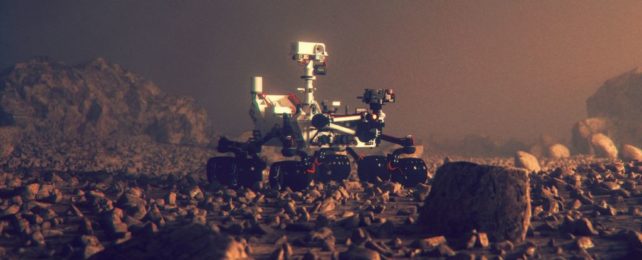Mars rovers tasked with hunting for traces of biology could roll over microscopic life forms without smelling a thing, simply because their instruments aren't up to the task.
A new study carried out in Earth's oldest desert shows how current technology can't always spot the signatures of life on our own planet's surface. Let alone on Mars'.
The researchers behind the investigation argue that without improving our ability to identify long-dead 'microbial dark matter', life on Mars will continue to elude us. Especially if the life we are searching for existed billions of years ago when the planet was warmer and wetter than it is today.
Chile's Atacama Desert features an ancient delta called the Red Stone, which contains sand and rock rich in hematite and mudstone. Geologically, this region is quite similar to parts of Mars, which is why astrobiologists often use it as a model for the red planet.
When researchers in Chile tested the Red Stone's mineralogy with the best instruments available today, they uncovered some mysterious signs.
Nearly 9 percent of the genetic sequences obtained using Next Generation Sequencing fell into the 'unclassified' category, whereas 40 percent of the remaining sequences could not be assigned to anything more specific than the highest of taxa, such as orders or domains.
Researchers from the Autonomous University of Chile (Universidad Autónoma de Chile) say their findings unveil "an unusual high degree of phylogenetic indeterminacy."
The team has proposed a new concept to represent that uncertainty, what they call a "dark microbiome". This term essentially refers to microorganisms that scientists can detect via genetic sequencing without knowing exactly what they are.
"Thus," researchers write, "the Red Stone dark microbiome may be composed by truly novel extant species not found anywhere else on Earth, but it may also be the case that such dark microbiome in fact represents the relict community of microbial species which used to inhabit the Red Stone delta in the distant past, of which no extant relatives are to be found in the existing sequence databases."
The Red Stone samples were also analyzed by testbed instruments used on Mars or destined for Mars, showing detection of microorganisms to be far more challenging, with limited or non-detection in most cases.
Last year, the Perseverance rover on Mars found 'strong signs' of organic matter when rolling through an ancient river delta.
In the years before that, the Curiosity rover picked up signs of organic molecules in both sand and dried-up mud.
Those are promising discoveries, but organic matter isn't a sure sign of life. It's still unclear if those molecules actually have biological origins.
"Our analyses by testbed instruments that are on or will be sent to Mars unveil that although the mineralogy of Red Stone matches that detected by ground-based instruments on the red planet, similarly low levels of organics will be hard, if not impossible to detect in Martian rocks depending on the instrument and technique used," researchers in Chile conclude.
"Our results stress the importance in returning samples to Earth for conclusively addressing whether life ever existed on Mars."
For years now, NASA has been planning to retrieve their samples from Mars to take a closer look. But that's easier said than done. Going to Mars and back requires a space mission to go further than ever before.
The date for this historic moment is currently set for some time in the 2030s or 2040s. Hopefully by then our technology will be better equipped to take a proper look at what we have found.
The study was published in Nature Communications.
